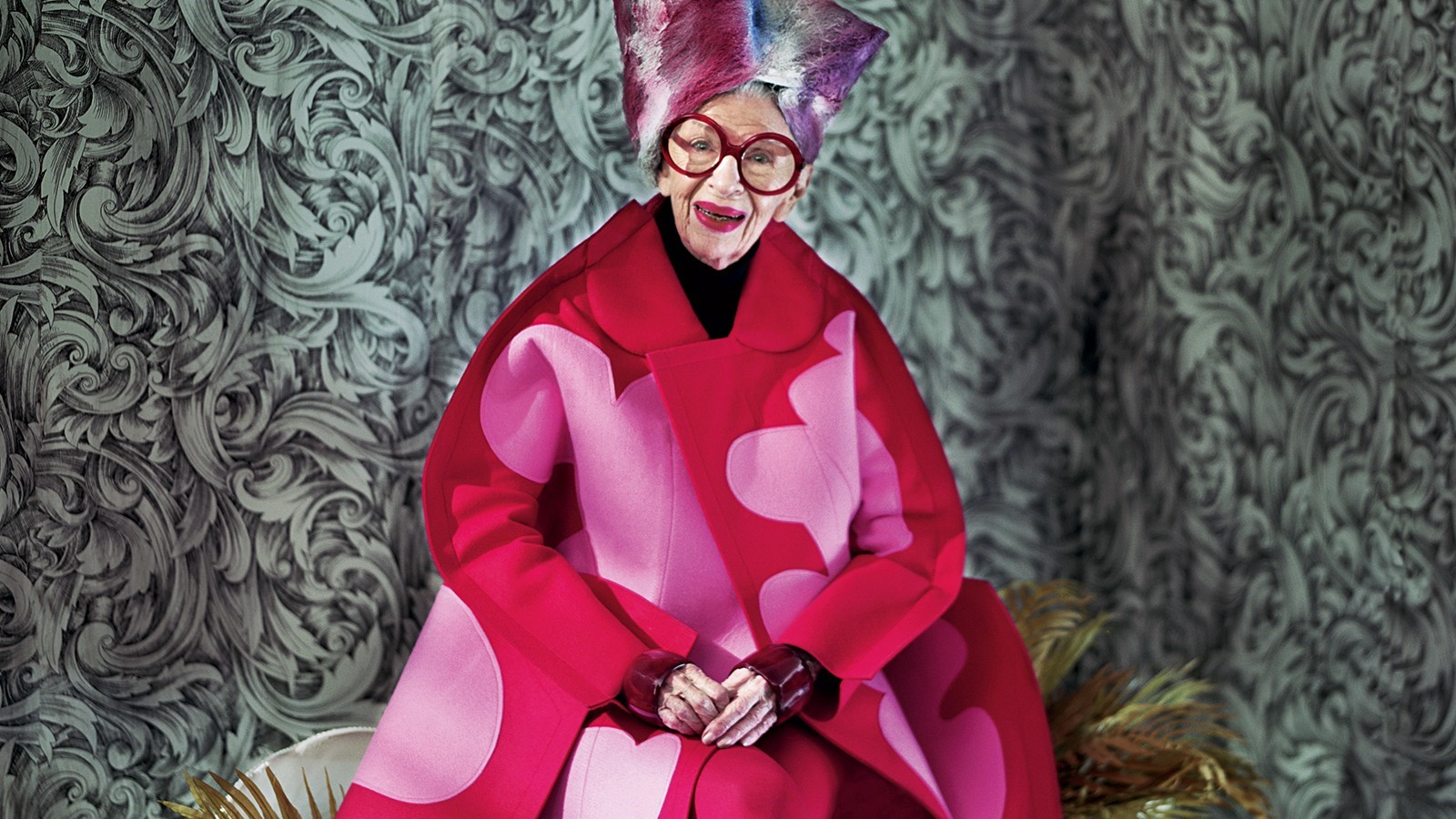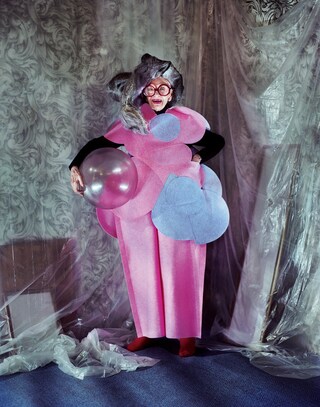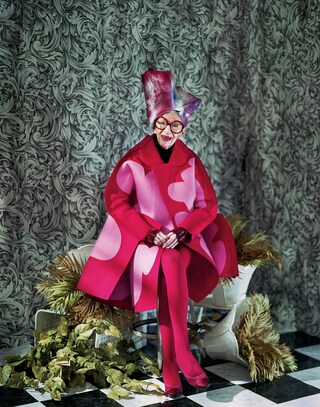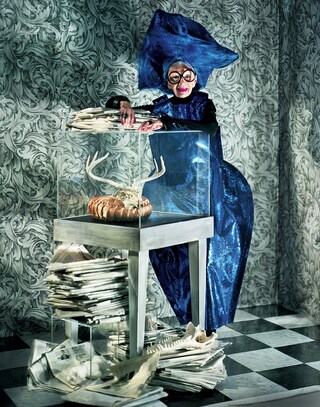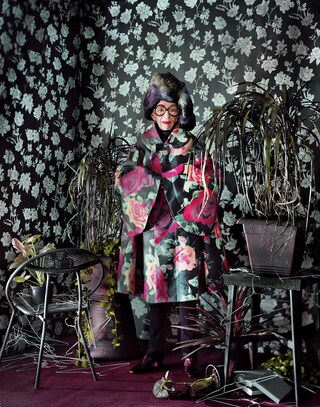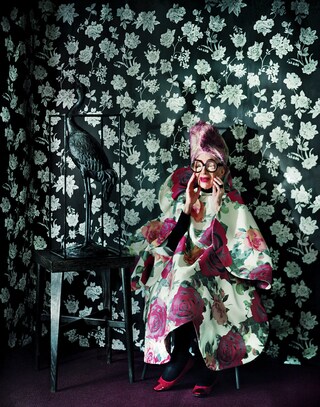‘Geriatric starlet’ Iris Apfel has passed away aged 102. Revisit the time she modelled Comme des Garçons’ AW12 collection for Dazed here
This article was originally published on November 5, 2012
“I want to make something clear,” says Iris Apfel, one Sunday afternoon in Manhattan. “Fashion is not my trade and it’s not my life. I don’t live to get dressed. I think getting dressed is wonderful and I love it, but there’s a whole big world outside of the closet.” Apfel, now 91, is reminding us that despite her recent rise to pop stardom and omnipresent distinction as a “style icon”, her life’s achievements span far beyond her wardrobe. Nonetheless, the textile tycoon and interior designer has become famous later in life with respect to – dare we say it? – the way she looks.
In a culture that fetishises youth, Apfel has become an unlikely idol, inspiring younger generations with an immutable confidence and a witty, more-is-more style. In 2005, the Metropolitan Museum of Art in NYC premiered Rara Avis (Rare Bird): The Irreverent Iris Apfel, an exhibition of her clothing that celebrated her flair for mixing haute couture, flea-market finds, furs and tribal trimmings. The show, which was the Met’s first exhibition about a living woman who is not a designer, brought in over 150,000 visitors, and went on to travel to numerous cities around the globe. As the New York Times art critic Roberta Smith put it, “Before multiculturalism was a word, Mrs Apfel was wearing it.”
“Oh yes darling, my Met show was an enormous smash,” she says with a flip of her heavily bangled wrist. “My nephew made a habit of bringing his friends to the show on weekends, and he’d overhear people talking about how they thought I was dead. I told him, ‘The next time you hear that just tap them on the shoulder and say, actually, my auntie is still very much alive, she’s just walking around to save funeral expenses.’”
The exhibition’s success propelled Apfel to heroine status – photographed by Bruce Weber for Vogue Italia and profiled in practically every fashion mag on earth, she also had her wardrobe documented in a book of photography and modelled in a Coach ad campaign. The acclaim has garnered her some new careers – she now has her own make-up collection for MAC, a line of eyewear for Eyebobs and an accessory line for the Home Shopping Network. (Despite all this, she still has a prehistoric cell-phone that lacks even texting capabilities, and refuses to use email. When I contacted her for quote approval, she asked to be faxed the article. When I said I didn’t have a fax machine, she responded, “Send a bike messenger.”) But the newfound attention is little more than a form of amusement for her. “I think it’s hysterical,” she says in her New York drawl. “My husband and I laugh about it all the time, because I’m not doing anything different than I did 70 years ago, and all of a sudden I’m so hot and so cool, and whatever the hell the kids say I am. It’s fun, but it hasn’t gone to my head.” She shrugs, then says, flippantly, “I call myself a geriatric starlet.”
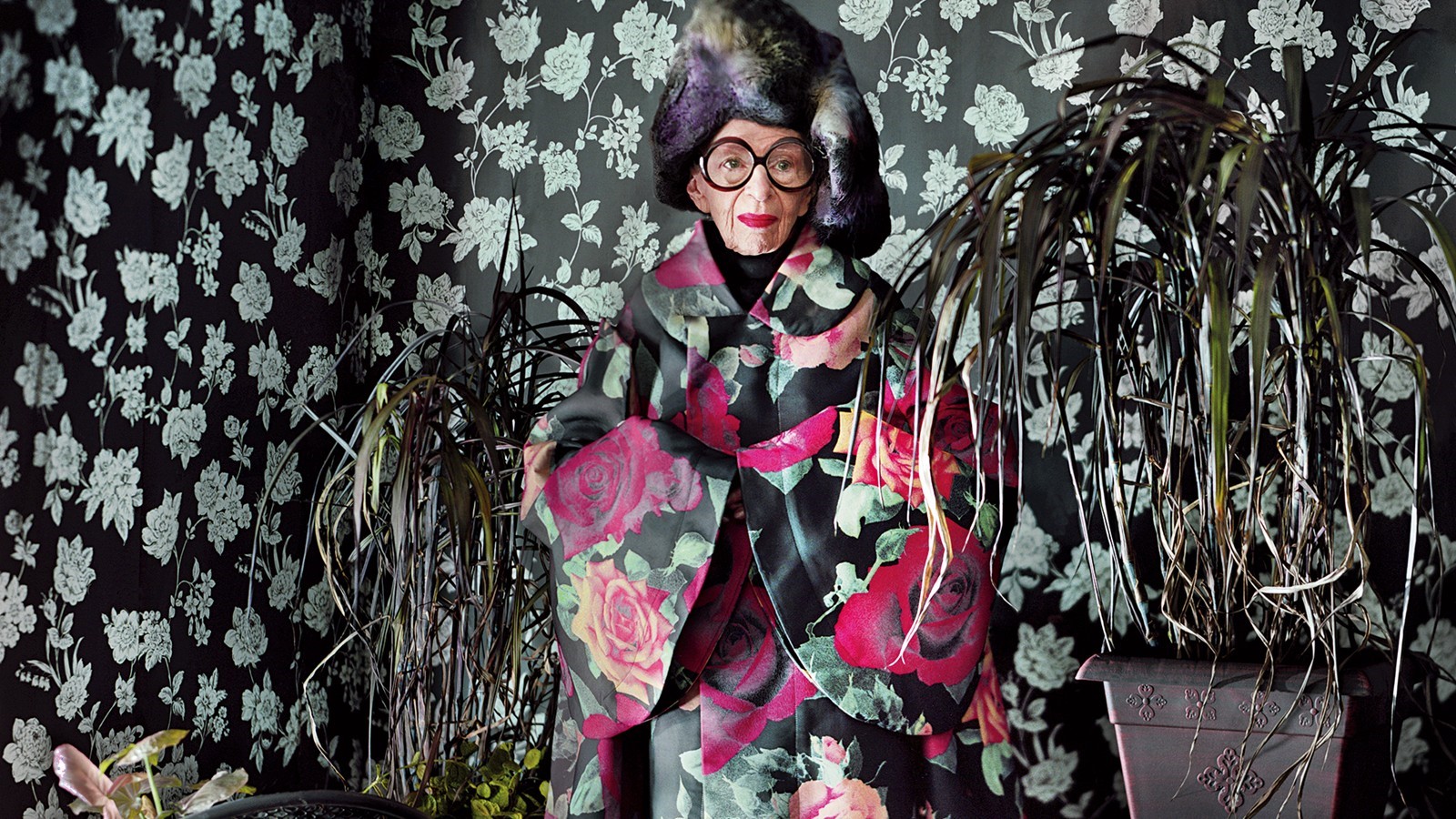
“Fashion” and “art” have long been two different conversations, but in recent years, the distinction has become increasingly tenuous. It is commonplace now for museums across the globe to host fashion exhibitions – McQueen, Gaultier and YSL have all had major museum shows, to name just a few. And it’s people like Apfel, with her visionary style, who have helped contextualise fashion as a modern artform. “I think these exhibitions are very important, because they bring new people into museums,” she says. “Some people are afraid of museums because they feel inadequate, like they don’t know enough about art. But people wear clothes every day, so they find fashion less intimidating.” Tellingly, museums have reported great surges in membership following their fashion exhibits, due to visitors feeling like they could relate to the work shown.
“I absolutely consider fashion a form of art. Of course, a lot of people put effort into looking awful. But there are also people making bad art. It’s not what you do, it’s the way that you do it”
“I absolutely consider fashion a form of art,” smiles Apfel from behind her signature owl-frames. “Of course, there is some fashion that is not art at all – it’s utilitarian, made for the purpose of covering up. And there are a lot of people out there who put a lot of effort into looking awful. But there are also people putting the same amount of energy into making bad art. It’s not what you do, it’s the way that you do it.”
Apfel grew up in Queens, New York. Her father owned a glass and mirror business, and her mother owned a fashion boutique that sold mainly accessories. Both parents clearly made a lasting impression on young Apfel. “My father was really quite a master,” she recalls. “He did exquisite mirror-work, and he worked for a lot of great interior designers, so he really put the bug of interior design in my head. And my mother was very chic, and very accessory-conscious. I always say that my mother worshipped at the altar of the accessory. She taught me how transformative accessories are – how they can take the same simple, unadorned outfit from the office in the morning to a cocktail party at night.”
In 1948, she married Carl Apfel. Sixty-four years later, the pair are still very much together. In the 50s, they founded textile firm Old World Weavers, which they ran together until they sold it in 1992 (although they stayed on as consultants till 2010). “We did exact replications of 17th, 18th, 19th and early 20th-century fabrics,” she explains. “I accumulated wonderful, antique fabrics from all over the world – not your standard, run-of-themill textiles – and we recreated them in exquisite quality.” With Iris as creative director and her husband running the business aspect, the company became a great success, and together the pair travelled the globe looking for new design inspirations. Devoted clients included Greta Garbo, Jacqueline Onassis and Estée Lauder. They also did work at various museums, including the Metropolitan Museum of Art, and were hired by the White House to perform historic restorations during the administrations of nine presidents.
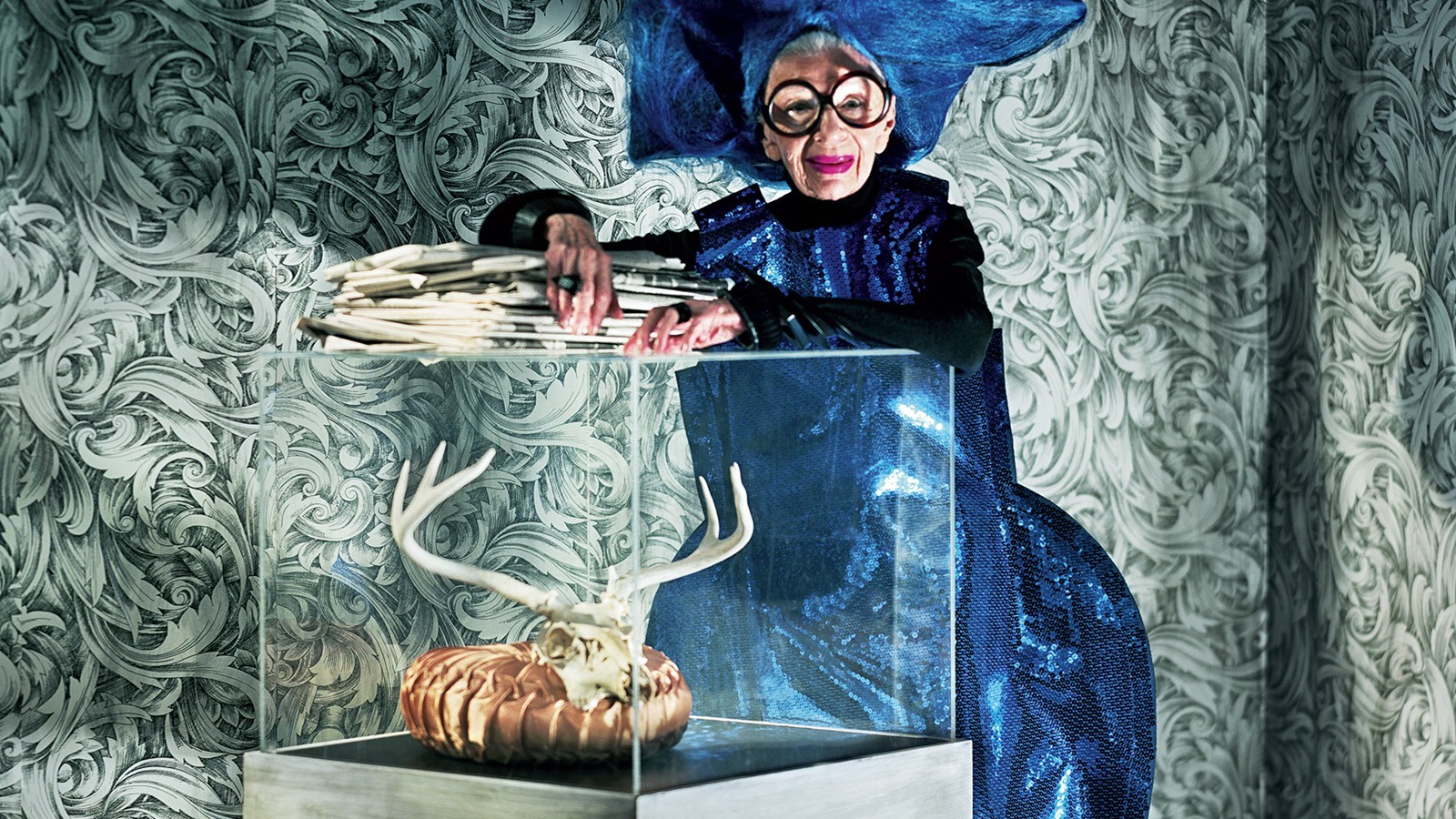
“We did major work at the White House,” she says. “But what people often don’t understand is that when you do a historic restoration, you can’t just do whatever you want. You work alongside the fine-arts commission and are obliged to create a replica of the past, as close as humanly possible. It’s a historic institution, not a showhouse. The presidents have nothing to do with the way things look, and neither do their wives. If presidents’ wives got involved in the decorating, God knows what we’d have.”
Today, in a Manhattan photo studio overlooking the Hudson River, Apfel is wearing pieces from the new Comme des Garçons collection for her Dazed cover-shoot. Seeing Apfel standing regally in Rei Kawakubo’s playful 2D designs, her own oversized frames and a towering wig brings to mind a quote from long-time Comme fan, John Waters: “Rei Kawakubo’s work is never funny, but her wit is so ferocious, so elegant, so scary, and sometimes even so ridiculous, that her customers never have buyer’s remorse. How could they feel that they overspent when they look so courageous, cult-like, superior, and even slightly insane every time they get dressed in one of her outfits?”
“I think Rei is a great artist,” Apfel says, “and that wearing her clothes is an artistic experience. It’s art in the shape of clothes!” She smiles. “I’ve bought a couple of her things in the past, but they were always very strange and I couldn’t figure out how to put them on. But these pieces are extraordinary, because they’re so different. Rei is a contrarian – if everybody else is doing black, she does white. I read somewhere that she decided to make 2D clothes because other designers had become so concerned with 3D elements, like the way the back of a garment looks.” She looks down at her tiny frame, lost in a gigantic, electric-pink overcoat. “I mean, look at me, I look like I’m down the rabbit-hole! But I don’t mind. I don’t think fashion should be taken so seriously. It’s something you should adapt to your mood and spirit."
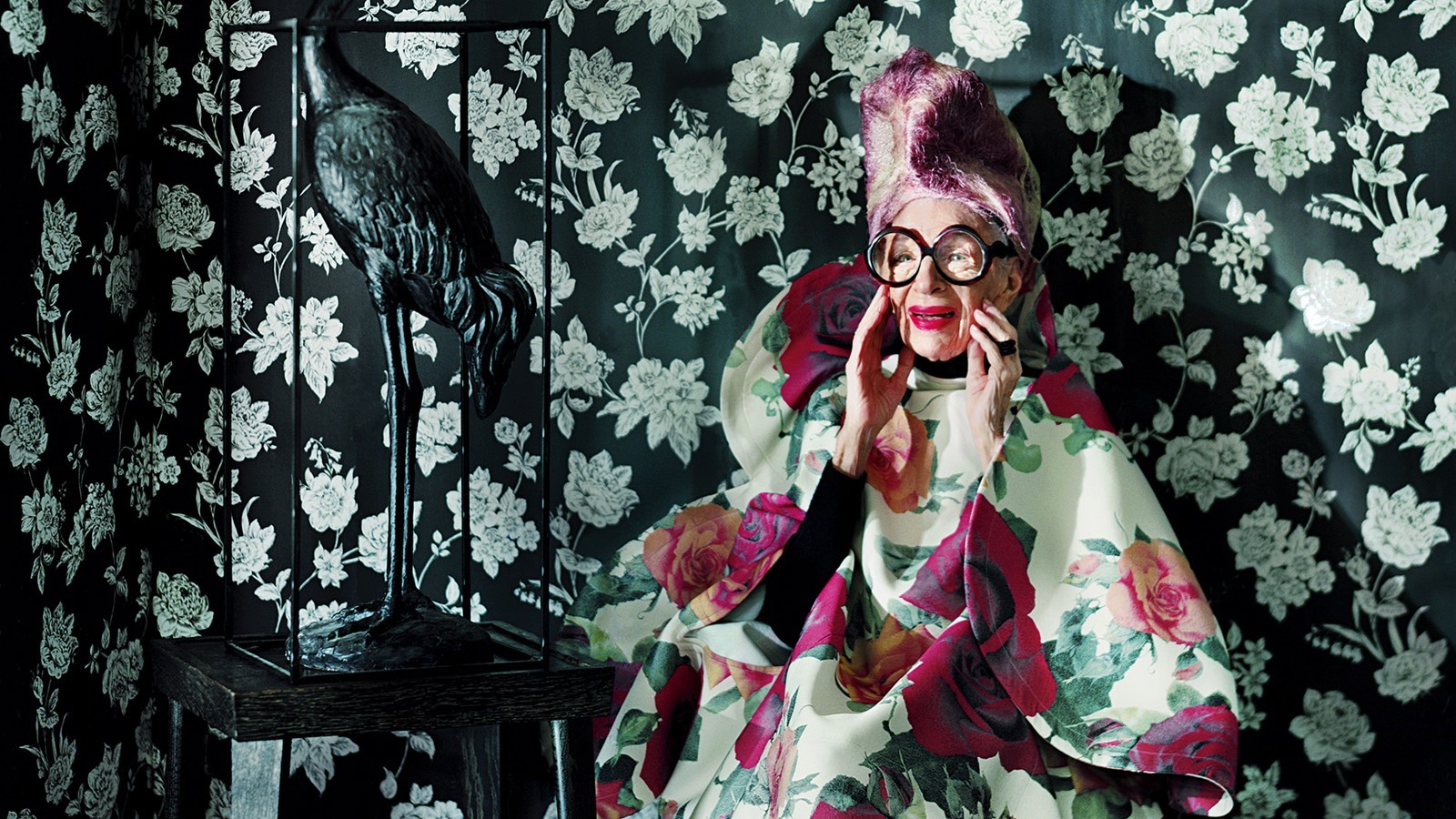
Also at the studio today is the famous documentarian, Alfred Maysles, who Apfel lovingly calls the “granddaddy of documentary film.” Maysles is currently making a film about Apfel, to be released next year. “That face is something special,” he says of Apfel. “And adorned by those big glasses – you can stare at her for a long time, she’s so striking. You know, there’s a photograph of her in the Observer Magazine, and it’s a full page of just her face, and you really can’t peel your eyes away. It’s just enjoyable to see somebody of that age who’s so active and so engaging.”
“Just because you get to a certain number doesn’t mean you have to roll up into a ball and wait for the grim reaper,” interjects Apfel. “We were put on this earth to do something! If you stop using your brain, at any age, it is going to stop working. It’s like if you stop using your hand, it will atrophy. I think doing nothing is a curse.”
Unsurprisingly, aging is a topic upon which Apfel is often called to offer words of wisdom. “It’s a terrible thing how women these days are silently and subliminally bombarded with a fear of aging,” she says solemnly. “The advertising is disgusting. Cosmetics companies, in their ads, use 16-year-old models with flawless skin, then they retouch them until they look unhuman. Who can look like that? And if you have a little bit of confidence and half a brain, you shouldn’t be upset by this, but people are. American women are really psychopathic about the way they look – and it’s becoming the same way in Europe, so I’m told – and it’s pitiful and very sad. I mean, relax, have fun! You can look beautiful at any age, but you have to be intelligent enough to know that if you’re 90 and you go and get your face carved up, no one is going to think you’re 25. Trying to look like a spring chicken when you’re not makes you look ridiculous. I think it was Chanel who said, ‘Nothing makes a woman look so old as trying desperately hard to look young.’”
“I was never hurt by what anybody said about my clothes, because I dress to please myself. If somebody doesn’t like what I’m wearing, it’s their problem, not mine”
It doesn’t take much time with Apfel to get the sense that, from a very young age, she was equipped with a rigid sense of who she was, and little need for the approval of others. “I was never hurt by what anybody said about my clothes,” she says plainly, “because my feeling has always been to dress to please myself. If somebody doesn’t like what I’m wearing, it’s their problem, not mine.” Though she looks sweet, there’s a toughness about her that’s very charming. She’s brutally frank, and she’ll be the first to tell you she doesn’t care to bite her tongue.
“I was at this business occasion not too long ago,” she says, “and a woman came up to me and asked me how I thought she looked. And I said, ‘Do you really want to know?’’ and she said ‘yes’, and asked me to please be very honest. So I said, ‘Well in my view, you look like a hooker.’ And then everybody’s jaws dropped and their eyes bulged, and I thought, ‘Oh God, I really loused myself up this time.’ I thought she was going to smack me, but lo and behold she threw her arms around me and kissed me. She said it was the nicest thing anybody ever said to her.”
Somehow, Apfel’s honesty never comes across as insulting. In her dry, irreverent, witty drawl, everything she says seems like casual words of wisdom relayed from the gods. “The worst fashion faux-pas is looking in the mirror and seeing somebody else,” she asserts. “Just because Angelina Jolie looks divine on the runway doesn’t mean you’re not going to end up looking like a horse’s ass in the same outfit. You have to know who you are and what you can carry off. And learning who you are is not easy, so you have to work at it. Because you’re never going to be elegant or stylish mimicking somebody else. You might be fashionable, but fashion and style are two very different things.”
We worship great artists because of a fundamental belief that the magnificence of a creation reflects a magnificence in its maker. Apfel, in her transcendent style, has made herself into both the artist and the work of art. The painter and the painting. “I think to follow something slavishly, just because everyone is doing it, is nuts,” she says, eyes wide. “It’s OK to take risks. The fashion police aren’t going to come get you and put you in jail. All you can do is make a mistake, and what’s so bad about that?”
Click HERE to view Jeff Bark and Robbie Spencer's film and HERE to read more about Albert Maysles' upcoming Apfel documentary
Taken from the November 2012 issue of Dazed & Confused
